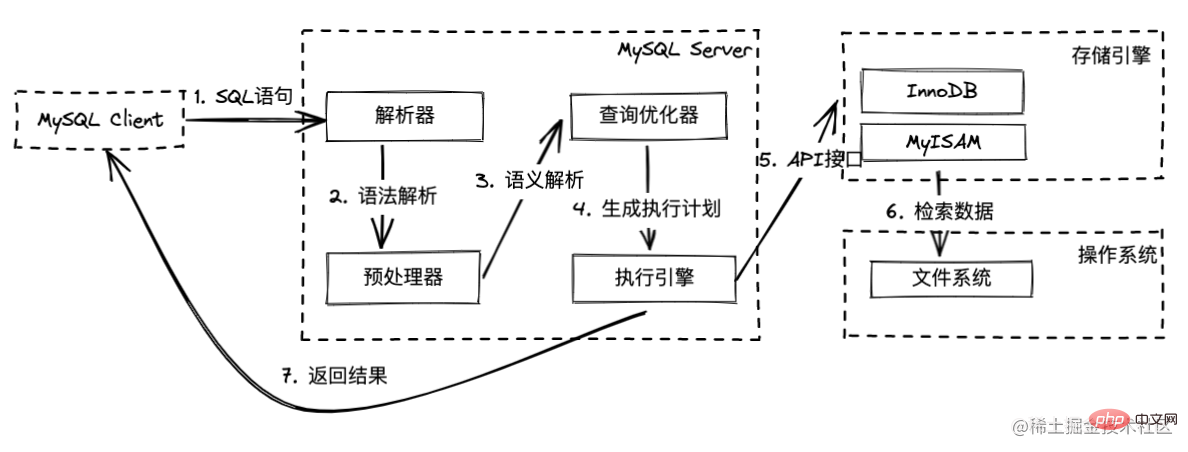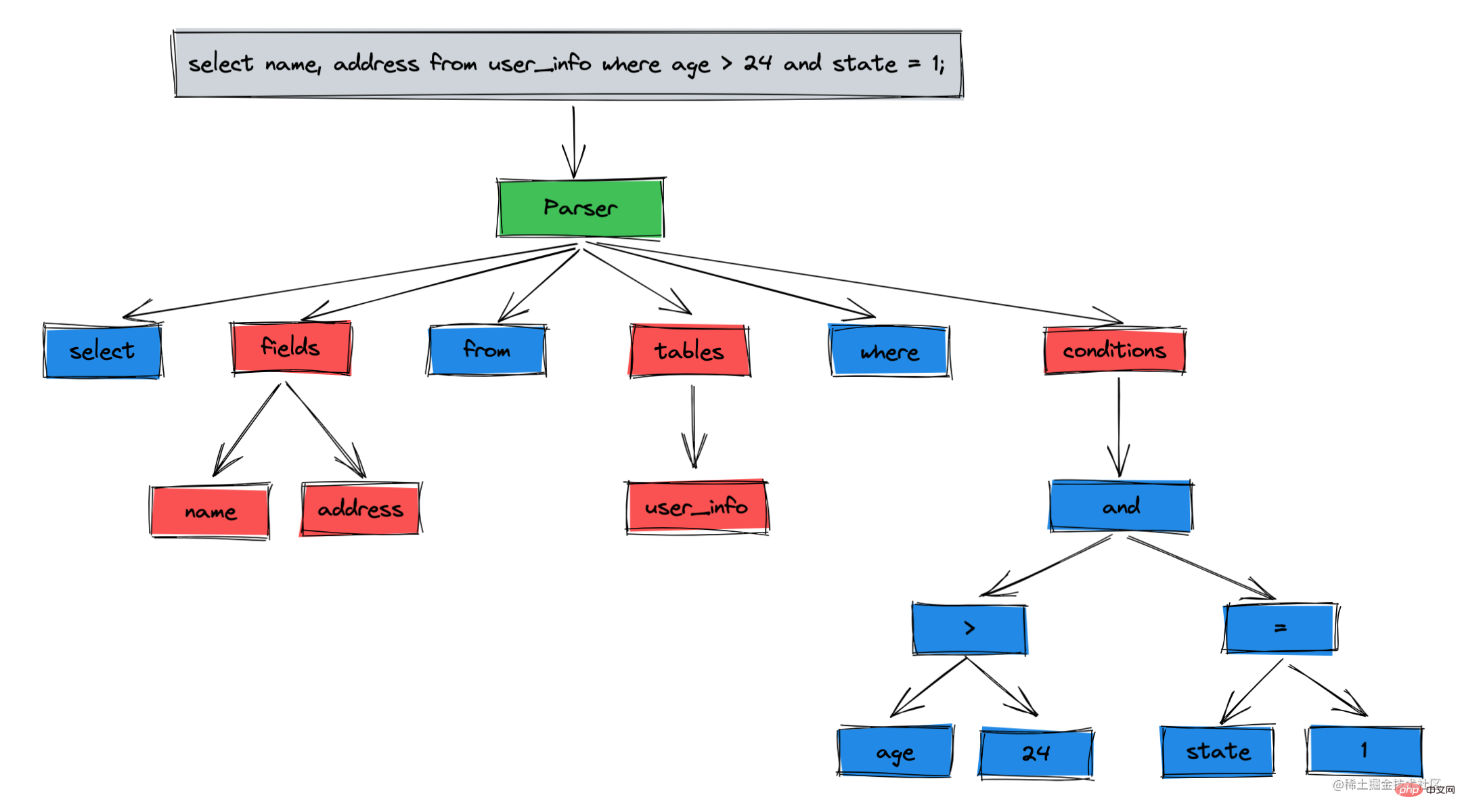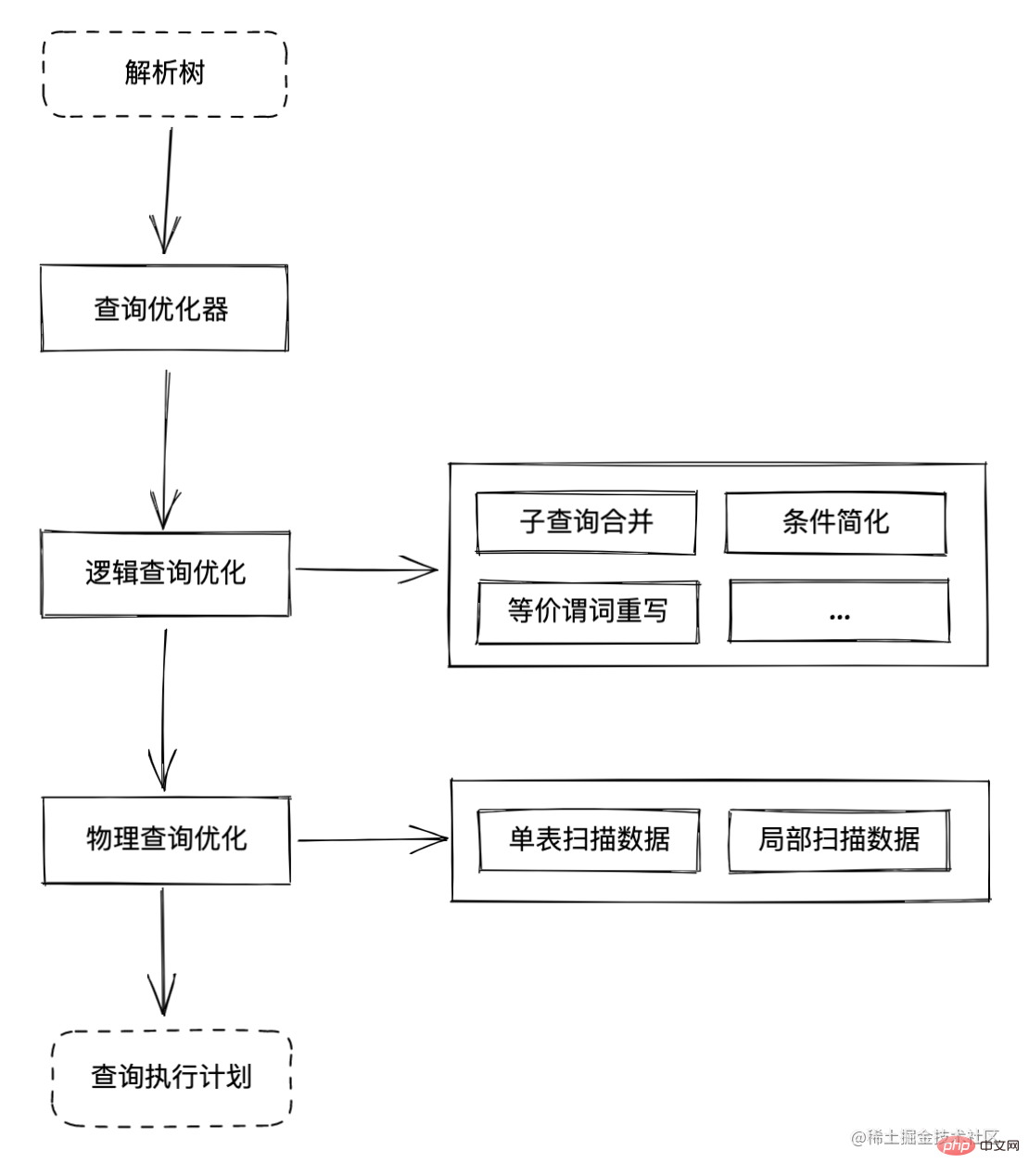MySQL learning to talk about query statement execution process
If you want to learn MySQL in depth, you should start from the macro architecture. In this article, we will learn the process of executing MySQL query statements. I hope it will be helpful to everyone!

The MySQL version of this article is 8.0.18
Architecture diagram

Parser
The function of the parser is to perform the following work on the SQL statement sent from the client:
- Grammar Parsing: Check the syntax of the SQL statement, whether the brackets and quotation marks are closed, etc.
- Lexical parsing: Split the keywords, table names, and field names in the SQL statement into nodes, and finally obtain a parse tree

Preprocessor
The parser mainly checks the grammar and lexicon, but if the grammar and lexicon are correct, but the table , the field does not exist, then this SQL statement cannot be executed correctly.
So the role of the preprocessor is: Semantic parsing, to determine whether the semantics of the parse tree is correct and whether tables and fields exist. After preprocessing, a new parse tree will be obtained.
Query optimizer
Query optimizer structure

The execution method of a SQL statement in MySQL is as follows Although the same results will be obtained in the end, there are differences in overhead. The specific execution method chosen is determined by the query optimizer. For example:
- There are multiple indexes in the table that can be selected. Which index should be selected?
- When we perform related queries on multiple tables, which table’s data should be used? For the benchmark table
The query optimizer is a cost-based optimizer. Its working principle is to evaluate various execution plans based on the parse tree. The cost required for the execution method, will eventually get an execution plan with the minimum cost as the final solution .
However, this execution method with the smallest overhead is not necessarily the optimal execution method. For example, an index should be used, but a full table scan is performed. Although there are two words "optimization" in the query optimizer, this optimization is not omnipotent. In many cases, it is more necessary to consider whether the SQL statement is written reasonably.
Logical query optimization
Logical query optimization is mainly responsible for performing some relational algebra to optimize SQL statements, thereby making SQL statement execution more efficient
We can use several cases to briefly understand logical query optimization
-
Subquery merging
Before merging
SELECT * FROM t1 WHERE a1<10 AND ( EXISTS(SELECT a2 FROM t2 WHERE t2.a2<5 AND t2.b2=1) OR EXISTS(SELECT a2 FROM t2 WHERE t2.a2<5 AND t2.b2=2) );
Copy after loginAfter merging
SELECT * FROM t1 WHERE a1<10 AND ( EXISTS(SELECT a2 FROM t2 WHERE t2.a2<5 AND (t2.b2=1 OR t2.b2=2) );
Copy after loginMerge multiple subqueries by merging query conditions, and reduce multiple connection operations to a single table scan and a single connection
Equivalent predicate rewriting
Like the familiar like fuzzy query, % is written after the condition before the index range query is performed. In fact, this is the credit of the query optimizer
Assume that the conditions used are all indexed, before rewriting
SELECT * FROM USERINFO WHERE name LIKE 'Abc%';
Copy after loginAfter rewriting
SELECT * FROM USERINFO WHERE name >= 'Abc' AND name < 'Abd';
Copy after loginThis is why the answer to index range query
-
Conditional simplification
Conditional simplification is also used Some equations and algebraic relationships are used to achieve simplification
- Remove redundant brackets in expressions and reduce the levels of AND and OR trees generated during syntax analysis, such as
((a AND b) AND (c AND d))is simplified toa AND b AND c AND d - Constant transfer, such as
col1 = col2 AND col2 = 3is simplified tocol1 = 3 AND col2 = 3 - Expression calculation, some expressions that can be directly solved will be converted into the final calculation result, such as
col1 = 1 2Simplification Forcol1 = 3
- Remove redundant brackets in expressions and reduce the levels of AND and OR trees generated during syntax analysis, such as
##Physical query optimization
The main work of physical query optimization is based on SQL Statements evaluate the cost of multiple execution plans respectivelyPhysical query optimization mainly solves the following problems:- Which method is the least expensive in single table scanning? (scan index back to table or full table scan)
- When there is a table connection, which connection method is the least expensive to use
| Cost evaluation formula | |
|---|---|
| N_page * a_page_IO_time N_tuple * a_tuple_CPU_time | |
| C_index N_page_index * a_page_IO_time |
The above is the detailed content of MySQL learning to talk about query statement execution process. For more information, please follow other related articles on the PHP Chinese website!

Hot AI Tools

Undresser.AI Undress
AI-powered app for creating realistic nude photos

AI Clothes Remover
Online AI tool for removing clothes from photos.

Undress AI Tool
Undress images for free

Clothoff.io
AI clothes remover

Video Face Swap
Swap faces in any video effortlessly with our completely free AI face swap tool!

Hot Article

Hot Tools

Notepad++7.3.1
Easy-to-use and free code editor

SublimeText3 Chinese version
Chinese version, very easy to use

Zend Studio 13.0.1
Powerful PHP integrated development environment

Dreamweaver CS6
Visual web development tools

SublimeText3 Mac version
God-level code editing software (SublimeText3)

Hot Topics
 MySQL's Role: Databases in Web Applications
Apr 17, 2025 am 12:23 AM
MySQL's Role: Databases in Web Applications
Apr 17, 2025 am 12:23 AM
The main role of MySQL in web applications is to store and manage data. 1.MySQL efficiently processes user information, product catalogs, transaction records and other data. 2. Through SQL query, developers can extract information from the database to generate dynamic content. 3.MySQL works based on the client-server model to ensure acceptable query speed.
 Laravel Introduction Example
Apr 18, 2025 pm 12:45 PM
Laravel Introduction Example
Apr 18, 2025 pm 12:45 PM
Laravel is a PHP framework for easy building of web applications. It provides a range of powerful features including: Installation: Install the Laravel CLI globally with Composer and create applications in the project directory. Routing: Define the relationship between the URL and the handler in routes/web.php. View: Create a view in resources/views to render the application's interface. Database Integration: Provides out-of-the-box integration with databases such as MySQL and uses migration to create and modify tables. Model and Controller: The model represents the database entity and the controller processes HTTP requests.
 How to start mysql by docker
Apr 15, 2025 pm 12:09 PM
How to start mysql by docker
Apr 15, 2025 pm 12:09 PM
The process of starting MySQL in Docker consists of the following steps: Pull the MySQL image to create and start the container, set the root user password, and map the port verification connection Create the database and the user grants all permissions to the database
 Solve database connection problem: a practical case of using minii/db library
Apr 18, 2025 am 07:09 AM
Solve database connection problem: a practical case of using minii/db library
Apr 18, 2025 am 07:09 AM
I encountered a tricky problem when developing a small application: the need to quickly integrate a lightweight database operation library. After trying multiple libraries, I found that they either have too much functionality or are not very compatible. Eventually, I found minii/db, a simplified version based on Yii2 that solved my problem perfectly.
 Oracle's Role in the Business World
Apr 23, 2025 am 12:01 AM
Oracle's Role in the Business World
Apr 23, 2025 am 12:01 AM
Oracle is not only a database company, but also a leader in cloud computing and ERP systems. 1. Oracle provides comprehensive solutions from database to cloud services and ERP systems. 2. OracleCloud challenges AWS and Azure, providing IaaS, PaaS and SaaS services. 3. Oracle's ERP systems such as E-BusinessSuite and FusionApplications help enterprises optimize operations.
 Laravel framework installation method
Apr 18, 2025 pm 12:54 PM
Laravel framework installation method
Apr 18, 2025 pm 12:54 PM
Article summary: This article provides detailed step-by-step instructions to guide readers on how to easily install the Laravel framework. Laravel is a powerful PHP framework that speeds up the development process of web applications. This tutorial covers the installation process from system requirements to configuring databases and setting up routing. By following these steps, readers can quickly and efficiently lay a solid foundation for their Laravel project.
 MySQL and phpMyAdmin: Core Features and Functions
Apr 22, 2025 am 12:12 AM
MySQL and phpMyAdmin: Core Features and Functions
Apr 22, 2025 am 12:12 AM
MySQL and phpMyAdmin are powerful database management tools. 1) MySQL is used to create databases and tables, and to execute DML and SQL queries. 2) phpMyAdmin provides an intuitive interface for database management, table structure management, data operations and user permission management.
 MySQL vs. Other Programming Languages: A Comparison
Apr 19, 2025 am 12:22 AM
MySQL vs. Other Programming Languages: A Comparison
Apr 19, 2025 am 12:22 AM
Compared with other programming languages, MySQL is mainly used to store and manage data, while other languages such as Python, Java, and C are used for logical processing and application development. MySQL is known for its high performance, scalability and cross-platform support, suitable for data management needs, while other languages have advantages in their respective fields such as data analytics, enterprise applications, and system programming.






